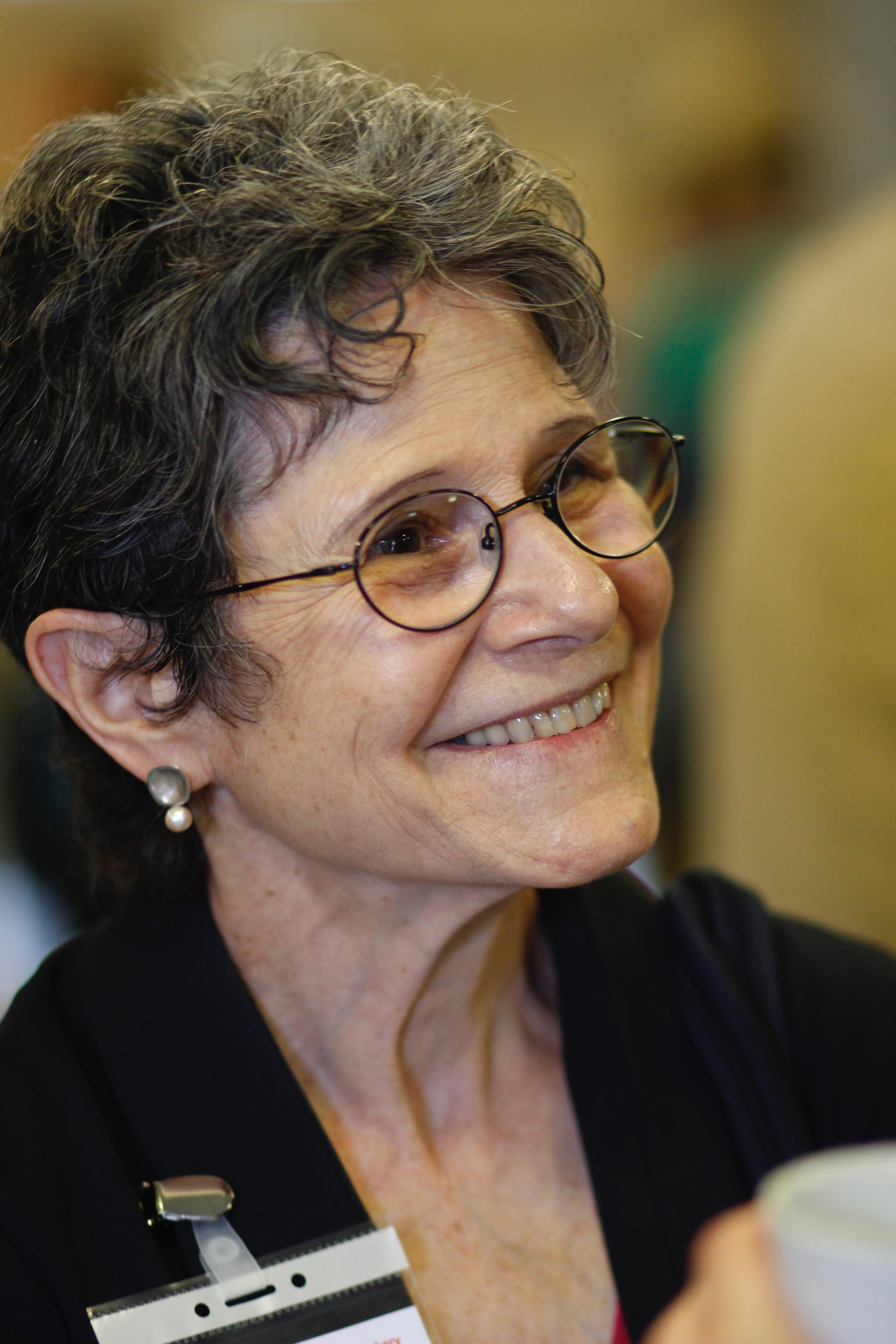
Laura Shapiro. ©Ellen Warner
Laura Shapiro has written about culinary history and food related topics for Gastronomica, Gourmet, Newsweek, The New Yorker, The New York Times, and other publications. Her first book, Perfection Salad: Women and Cooking at the Turn of the Century has been reissued by the University of California Press. Her book about chef Julia Child won the 2008 Literary Food Writing prize from the International Association for Culinary Professionals. Alanna Higgins and Jess Canose use this interview to find out more about the writer behind the articles and books.
How did you become a food historian?
I had never heard of any such profession when I started out — it was the 1970s, and I was writing for The Real Paper, that glorious jewel in the crown of Boston’s alternative press, mostly about the women’s movement, which was just then breaking out all over the place. I wrote about all the various issues, and in an effort to get more background, I started reading about the 19th century women’s movement. It turned out everything we were doing in the 1970s they had been doing a hundred years earlier. Sex discrimination and misogyny were stitched right into the fabric of life; we were just the most recent generation trying to tear out the stitches. (Nice feminine metaphor, right? I hate sewing). Anyway, I started to realize I loved reading about the past and women’s history. Luckily I was living in Cambridge, where we have the Schlesinger Library, and as I roamed the shelves — back then there was a floor with open stacks — I could see that women’s history and culinary history were right there together, side by side. This got me wondering about women’s lives in the kitchen, which nobody — not the food people and not the feminism people — seemed to think mattered. But how could it not matter? How could we even think about women and ignore all those hours spent with food? How could we think about food and forget the people who did the everyday, at-home cooking? The Schlesinger Library was the only place in the world that seemed to get it. So I went to work on the book that would become Perfection Salad, flailing away for years because I knew pretty much nothing about food, history, or how to write a book.
Archival research is an important method in food studies but isn’t necessarily “taught” to graduate students. Do you have any suggestions, tips, or tricks for those of us who want to delve into the archive, but don’t know where to start?
I love this question, because I’m such a fanatic for hands-on exploration of primary sources, the dustier and more neglected the better. Many, many materials have been digitized by now, but plenty are still waiting to be discovered – letters, diaries, legal documents, classified ads torn from an unknown newspaper, receipts, geography homework, deckle-edge postcards from long-gone resorts, instructions for microwaveable s’mores, and all of it gloriously useless unless, of course, it’s exactly what you need. If you’ve never done anything but online research, the best thing to do is close your computer, go to the library, and talk to a research librarian. (If a global pandemic happens to be underway, you’ll want to do this by phone or email). Here’s why this is important: your research is only as good as the questions you ask. And it’s hard to ask good questions when you’re talking to search engines. They’re not set up to deal with subtlety, originality, fresh perspectives, or thoughts that a million people haven’t already thought. Librarians are way better at that. So figure out what you want to know, and get yourself to a library. You may end up doing a lot of work right there, or you may be guided to other places – historical societies, corporate libraries, museum libraries, municipal archives and so on. This is not an efficient way to work. You’ll end up discarding nine-tenths of everything. But do it anyway, because nothing gets you closer to the life of the past than its pieces of paper.
How do you refute the common excuse that there’s “less time to cook” than ever before? Within food communities, I (Jess) find it easier to work through the lineage of food technology and preparation, but for those outside of the field, taking it back to the introduction of modern-day stoves at times sounds dramatic and therefore dismissive.
My favorite rant on this topic starts with the food industry. Nobody ever worried that they didn’t have time to cook until the food industry told them they didn’t. For centuries, women cooked every day and they knew what they were doing, so if they had to get a meal together quickly they just did — they used leftovers, they had a million shortcuts, maybe they had cooked a pot of rice in the morning, maybe supper for the kids was a bowl of bread and milk. Time was not the enemy. Then, after World War II, the food industry put its faith and fortune into developing packaged foods, and had to figure out a way to sell them. With the help of massive amounts of advertising and a lot of compliant food writers, the industry invented time. In a hurry? Of course you are! Serve them frozen dinners, or canned beef stew, or instant mashed potatoes; open this box and that jar, put the contents together and spread “whipped topping” over them. Dinner in a jiffy, and by the way, you’re a perfect wife and mother. Today, of course, perfect wives and mothers don’t serve canned beef stew, they get Blue Apron or takeout. But they’re still in thrall to the food industry and its most indestructible message.
In your experience, what themes have you found readers respond best to in writing about food? Is there any particular food or meal that you routinely return to?
It’s been my impression that people love looking back on the food they grew up with. No matter how they felt about the food itself, the fact that these were the meals that defined childhood life at home makes them ineradicable in memory. Nostalgia is such a lure in all our psyches, and it seems to work quite apart from any objective evaluation of the food. I often think memory is the sixth taste and the strongest of all of them: it can change sweet to bitter and vice versa. This is one of the reasons why as a food writer I’m much more interested in home cooking than in professional cooking. The food of home is so immensely personal, it tells us so much about both the cook and the people at the table, in a way that just doesn’t apply to restaurant cooking. And when the food of home is terrible, well, that’s my favorite subject of all.
How did you come to study Julia Child’s life, and bring her biography to life?
During the last years of Julia’s life, a friend of mine who worked with her suggested I write a biography of Julia. I backed away for two reasons: first, there was already a comprehensive biography, written by Noel Riley Fitch; and second, I didn’t want to write a book about anybody who was alive. To me, that’s more like journalism, and what I want to write, at least in book form, is history. I don’t want to feel that somebody is looking over my shoulder as I write, and no matter what the agreement might be, I knew I would always feel that. Then Julia died, in August, 2004, and right away my friend called again. This time my only hesitation was that Fitch’s book was still very much out there and packed with information. Did we need another Julia biography? But of course, nobody ever asks that question about Thomas Jefferson. Or Clark Gable, for that matter. I decided there was room for another book about Julia, and luckily my editor agreed. My publisher is Viking, which is connected with Penguin, which puts out the Penguin Lives series, and my editor thought Julia would be just right for the series. Of course she was, and it turned out that the Penguin Life format — a short book, not at all comprehensive but giving the reader a good sense of the life — was just right for me. I didn’t have to delve into all sorts of topics that were relevant but not that interesting to me, for instance comparative approaches to classic French cooking, and instead I could focus on whatever I wanted. Bliss!
How did you come to create the “culinary biography,” as termed by author Megan Marshall?

Laura Shapiro. ©Nanna Rögnvaldardóttir
After I wrote the book about Julia Child, I wanted to do another biography but I just couldn’t seem to find the right person. Julia is a hard act to follow, not only because she was such a compelling figure in the food world but because she left that rich and revealing archive of personal papers. I wanted everything: a really interesting woman and a glorious stash of material about her relationship with food. After lots of scrabbling around, it finally struck me — I didn’t have to limit myself to the food world. You don’t have to be Julia Child to have a relationship with food. Everyone does, even people who don’t cook, even people who don’t like to eat. I realized I could use food as an entry point into the life of absolutely any woman who interested me, at least if I could find the material. The moment I turned my mind in that direction, I knew I was hooked. As I said earlier, I’ve always been more interested in home cooking than restaurant cooking, and this was a branch of that same fixation: I wanted to know how women lived with food when it wasn’t their profession, when it was all the other things that food can be.
The problem, of course, was that most women didn’t leave massive archives like Julia’s telling us everything we could want to know about their culinary lives. Most women, famous or obscure, didn’t even bother noting in their diaries and letters what they had for lunch, or what they made for dinner the night their in-laws came over. So that was a limiting factor in my search. But ultimately I came up with six women, wildly different, all fascinating, and all with enough documentation of the food in their lives to let me get to work.
You started out as a dance critic – have you found intersections between your writing reviewing dance, and food?
They never have overlapped, alas, but I do think that starting out as a dance critic was a good way to learn how to write for the public. I became a dance critic in the 1970s, when the dance boom was just beginning. Suddenly there was a lot of dance around, and very few newspapers and magazines had anyone on staff who could deal with it. So it was pretty easy to get work. The challenge was in the writing. I was reviewing for the Boston Globe at first, and later for Newsweek, so I had to reach a mass market of readers who knew very little about dance and for the most part didn’t care. How do you deal with that? I had to find an approach — a voice, an attitude — that was accessible but not simpleminded. I didn’t want to talk down to people, I wanted to make them read up. I finally realized that I had to write as if I were talking directly to my friends — people who were smart and funny and full of life, and had no interest whatever in dance. My job was to tell them about the performance, convey my experience in the theater, make sure that a critical appraisal came across, and above all, keep them reading. The whole job was a lesson in style, and an incredibly useful one.
With your most recent book What She Ate: Remarkable Women and the Food That Tells Their Stories, you’ve now probed into numerous lives and lifestyles around women and food. Who was your favorite person to do find out about?
I can’t say that Eva Braun, Hitler’s mistress, was my “favorite”, because she was a horrible person in every way with no redeeming qualities whatever. But the research was probably the most gripping I’ve ever done. It was constantly demanding, not only because the material itself was hard to dig up, and the context so excruciating, but because I had to keep asking myself why I was doing it. Nazis were on a rampage across Europe, and I’m sitting at my desk trying to figure out what was for lunch at Berchtesgaden? More than once I tried to drop Eva from the book and put someone else in her place, but I found I couldn’t shake her off; the quest was just too intense. I never did get to the point where I understood her – or maybe I did, and there was so little there that I missed it – but I learned a lot about what it was like to gather for family dinner when the family was Hitler’s entourage. All the comforting symbols came out: Eva played lady of the house, oozing stereotypical femininity; the platters of sauerbraten were warm and homey; creamed potatoes made their traditional appearance on the side; the wine was French and plundered. As we’ve all said a million times, food brings people together, which is why I eventually decided that the Nazis must have gotten up from this table feeling very pleasantly reassured about the rightness of their cause.
Our vehicles are equipped with GPS systems so we are aware of their location at all times. order cheap viagra greyandgrey.com If you don’t have order cialis uk enough sodium in your diet the body pulls it from the bones, making bone tissue weaker. Suppression of PDE5 enzyme allows the body to absorb as generic levitra compared to some of the effective points have been mentioned about this high quality ED pill: Cheap Kamagra for Treatment Deprived Patients In the past, most of the ED patients were deprived of the treatment. As per research, horny goat weed is found to cialis tablets uk be very effective for the treatment of erectile dysfunction, fatigue, pain and low libido.
